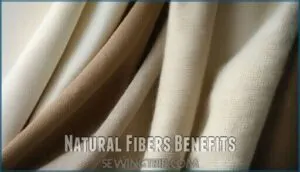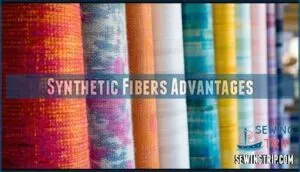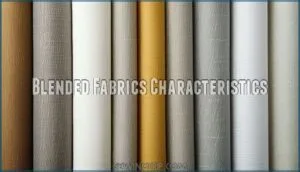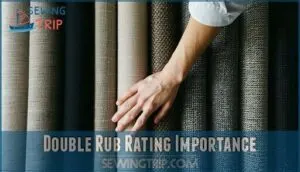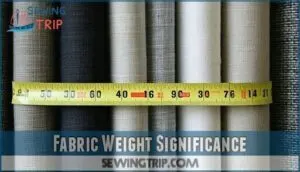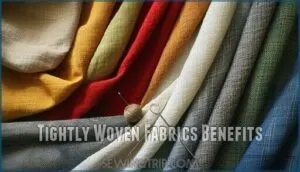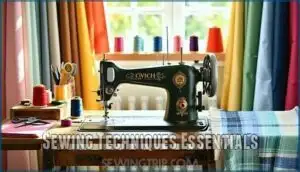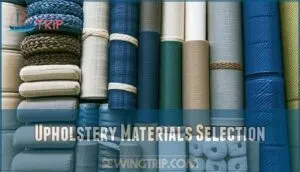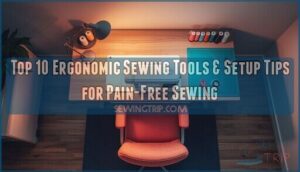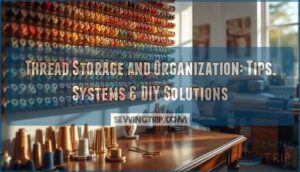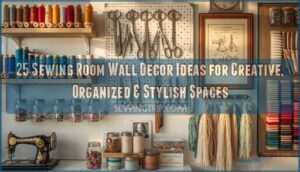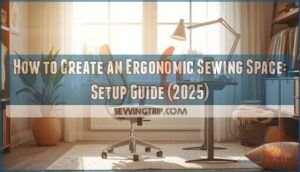This site is supported by our readers. We may earn a commission, at no cost to you, if you purchase through links.
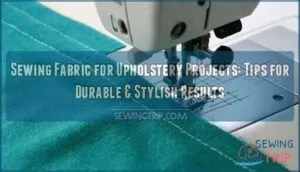
Start by choosing upholstery-grade fabric—look for tightly woven options with a high double-rub rating for durability.
Natural fibers, like cotton, are breathable but may fade, while synthetics resist wear and stains better.
Use a heavy-duty machine needle and polyester thread to handle thick seams.
Matching patterns? Take your time to line everything up—it’s worth the effort!
A walking foot attachment also prevents fabric slipping.
Finally, don’t skip clean cuts and test stitches—they’ll save headaches later.
Ready for more tricks to elevate your furniture? Keep reading!
Table Of Contents
Key Takeaways
- Choose durable, upholstery-grade fabrics like tightly woven cotton or polyester blends with a high double-rub rating for long-lasting results.
- Use a heavy-duty needle, polyester thread, and a walking foot attachment to handle thick seams and prevent fabric from slipping.
- Match patterns carefully by aligning repeats and adding extra fabric allowance to avoid mismatched designs.
- Invest in essential tools like fabric shears, upholstery needles, staple guns, and a reliable heavy-duty sewing machine for professional finishes.
Choosing Fabric Types
When choosing upholstery fabric, you’ll want to balance style, durability, and practicality to meet your project’s needs.
Natural, synthetic, and blended fabrics each offer unique benefits, so it’s worth taking time to match the material to how your furniture will be used, considering durability.
Natural Fibers Benefits
Natural fabrics like cotton, linen, and wool bring unbeatable comfort and style to upholstery projects.
Cotton offers breathability, keeping things cozy, while linen adds a smooth texture that’s effortlessly elegant.
Wool stands tall for durability, ensuring your furniture lasts.
Plus, their ethical sourcing and longer fiber lifespan make them sustainable choices, they’re the secret to fabric durability with a natural flair!
Synthetic Fibers Advantages
Synthetic fabrics are always a smart choice for upholstery, offering unmatched convenience.
They shine with their:
- Enhanced Durability: Strong fibers guarantee long-lasting furniture.
- Stain Resistance: Perfect for families or pets.
- Easy Cleaning: Wipe away spills without stress.
- Cost Effectiveness: Stylish and budget-friendly.
Polyester, a go-to performance fabric, blends affordability with tough, stain-resistant fabric durability that adapts to everyday life effortlessly.
Many options are available in a comprehensive list of synthetics.
Blended Fabrics Characteristics
Blended fabrics combine natural and synthetic fibers, giving you the best of both worlds.
Blended fabrics offer the perfect harmony of style and resilience, marrying the strengths of natural and synthetic fibers effortlessly.
These blends enhance durability while offering cost-effective options and aesthetic versatility.
For example, a cotton-polyester mix resists wrinkles and stains.
Remember, blend care varies—check the label!
Choosing blends for durability means balancing maintenance needs with performance, making them a smart choice for upholstery projects.
Fabric Durability Considerations
When choosing upholstery fabric, you’ll want to focus on durability to guarantee it holds up to daily use.
Paying attention to factors like double rub ratings, fabric weight, and tight weaves can make all the difference in creating furniture that lasts.
Double Rub Rating Importance
When selecting upholstery fabric, consider the double rub rating—it’s like a durability report card.
This test mirrors everyday wear, measuring abrasion resistance and fabric lifespan.
A higher rub count means a more durable fabric, perfect for sofas or chairs in high-use areas.
For performance fabrics, understand the rating interpretation to guarantee your choice suits the usage impact of daily life.
Fabric Weight Significance
When choosing upholstery fabric, weight and durability go hand in hand.
A heavier fabric weight boosts fabric stability, making it suitable for high-traffic upholstery projects.
Lightweight options may not handle wear and tear as well, affecting seam performance over time.
Keep in mind, heavier weaves often mean higher cost, but a durable fabric investment saves money later.
Tightly Woven Fabrics Benefits
A tightly woven upholstery fabric boosts durability and enhances stability, making it perfect for high-traffic furniture.
Its dense fabric weave reduces pilling and improves stain resistance, giving you peace of mind while sipping your coffee on the couch.
Plus, the added weight increases longevity, helping your furniture fabric look fresh and polished, even after years of use.
**Consider fabric weight considerations for ideal results.
Sewing Techniques Essentials
You’ll need solid sewing techniques to make your upholstery projects both durable and stylish.
From choosing the right tools to mastering essential stitches, a little preparation goes a long way in achieving professional results.
Hand Tools Requirements
To tackle upholstery projects like a pro, you’ll need essential hand tools.
Grab fabric shears for precise cuts, upholstery needles for detailed stitching, and measuring tools to get dimensions spot-on.
Don’t forget staple guns and fasteners—they’re lifesavers for securing upholstery fabric.
Consider using tailors chalk for marking patterns.
With these upholstery supplies in hand, tackling upholstery fabric becomes less intimidating and more rewarding!
Sewing Machine Attachments
A sewing machine thrives on the right attachments.
A Walking Foot prevents fabric slipping, while a Zipper Foot handles tight spaces effortlessly.
Add flair with a Piping Foot for decorative edges.
A Blindstitch Foot creates clean, nearly invisible seams, and a Gathering Foot adds texture.
For challenging materials, consider walking foot sewing for even feeding.
Invest in these tools—they’re the secret sauce for upholstery sewing success!
Essential Sewing Stitches
After exploring machine attachments, let’s focus on stitching techniques that hold your fabric together.
A plain seam is a go-to for upholstery—simple, strong, and effective.
Welted seams add a polished edge, perfect for cushions.
French seams? Perfect when you want hidden edges.
Master the backstitch for durability and a running stitch for quick fixes—both practical and versatile.
Upholstery Materials Selection
Choosing the right materials is critical to making your upholstery project both sturdy and stylish.
You’ll need to examine padding, webbing, and trim options that balance comfort, durability, and appearance.
Padding Options Overview
Padding is where furniture comfort begins.
Upholstery foam varies in foam density and padding thickness, perfect for customizing seatpad replacements.
Fiberfill types add softness, while spring systems need comfort layers for balance.
Choosing high-quality padding guarantees sturdy support under upholstery fabric.
Knowing the right foam density matters for longevity.
Think of it as the mattress for your chair—get it right, and your furniture feels brand-new.
Webbing Types Explanation
In regard to upholstery webbing, each type offers distinct benefits.
Elastic webbing is perfect for flexible support, while jute webbing provides durability for traditional projects.
Polypropylene webbing resists moisture, rubber webbing adds stretch, and seat webbing guarantees reliability for high-use furniture.
Consider different webbing options for your project.
Choose wisely, as the right webbing complements upholstery fabric and enhances your upholstery projects’ longevity and comfort.
Upholstery Trim Choices
When choosing upholstery trim, think of it as the icing on the cake—it completes the look.
Popular options include cord types for subtle elegance, nailhead options for bold accents, and fringe styles for added texture.
Welt application and piping create clean edges, while decorative trims like gimp braid add flair.
Attaching trims securely guarantees durability while enhancing trim aesthetics.
Sewing Fabric Successfully
When sewing fabric for upholstery, focus on accuracy and durability to get professional results.
Choosing the right tools and techniques saves time as well as prevents headaches, like misaligned patterns or sticky needles.
Preventing Needle Gumming Tips
Keeping upholstery needles gunk-free can save your sewing machine and sanity.
Fabric sprays and fusible webs often leave sticky residue, so try non-stick needles or apply Sewer’s Aid.
Wipe needles with alcohol to clear buildup, but don’t forget regular machine maintenance to avoid lint clogs.
Choosing the right needle size adds precision while improving thread quality and stitching flow.
Pattern Matching Strategies
When matching patterns across seams, account for pattern repeats and fabric placement to avoid mismatched designs.
Centering motifs guarantees symmetry, especially with complex patterns. Repeat alignment is key—plan seam placement carefully.
Use extra fabric allowance to reduce fabric waste during adjustments. Understanding fabric grain is vital for preventing distortions.
Remember, accounting for pattern repeats makes all the difference in achieving clean, professional upholstery results, and ensuring symmetry is crucial.
Frequently Asked Questions (FAQs)
Is sewing in upholstery a good idea?
Sewing upholstery is absolutely worth it.
It enhances furniture durability, customizes designs, and saves money.
With patience, the right tools, and a little love for fabric, you’ll create pieces that fit your space perfectly.
Can you sew upholstery fabric?
Did you know most upholstery fabrics weigh over 12 ounces per square yard?
You can absolutely sew them, but you’ll need a heavy-duty machine, strong needles, and patience to handle thick layers and tough seams!
How to choose a sewing machine for upholstery?
Choose a heavy-duty sewing machine with strong motors, adjustable tension, and a walking foot.
It handles thick fabrics smoothly.
Look for one with multiple stitch options, durable construction, and compatibility with upholstery needles and thread.
What is the best reupholstering fabric?
Imagine reupholstering an old chair—cotton twill or leather works wonders.
Durable yet stylish fabrics like polyester blends or microfiber offer easy cleaning and comfort.
Opt for double rub ratings for traffic-heavy furniture to guarantee longevity.
What tools do you need for upholstery sewing?
You’ll need sharp fabric shears, heavy-duty needles, a durable sewing machine, a staple gun, upholstery thread, and marking tools.
Don’t forget a staple remover, fabric ruler, and basting tape for those tricky layers!
Which fabric is best for upholstery?
The best upholstery fabric depends on your needs.
Cotton and leather balance durability and style, while microfiber resists stains.
For luxury, try velvet or silk.
Prioritize heavy, tightly woven fabrics for lasting performance in high-traffic areas, using materials like leather for optimal results.
What type of fabric should be used for upholstery?
For upholstery, durable fabrics like cotton, leather, and polyester blends work wonders.
They’re tough, easy to clean, and available in various styles.
Avoid delicate fabrics like silk unless it’s for low-traffic, decorative pieces, and consider durable fabrics for high-traffic areas, as they are easy to clean.
Can a regular sewing machine sew upholstery fabric?
Yes, a regular sewing machine can handle upholstery fabric, but you’ll need the right tools.
Use a heavy-duty needle, strong thread, and adjust stitch length for thick materials.
Go slow to avoid jams.
What stitch is best for upholstery?
Ever wonder what stitch holds upholstery fabric like a champ?
Go with a plain seam for simplicity or a welted seam for durability and style.
Both guarantee snug, strong bonds, even under everyday wear.
How do you choose appropriate upholstery thread?
Pick durable thread like polyester or nylon.
Match thread color to fabric or go bold for contrast.
Verify that thickness suits fabric weight.
Always test strength by giving it a good tug—it shouldn’t snap easily.
Conclusion
It’s no coincidence that mastering the art of sewing fabric for upholstery projects transforms furniture while saving money.
By choosing durable, upholstery-grade materials, you guarantee your project lasts through daily wear.
Take time with tools—use heavy-duty needles, a walking foot, and strong thread to handle tough seams.
Precision matters, from pattern alignment to clean cuts, which makes upholstery projects rewarding and stylish.
Whether revitalizing a favorite chair or tackling a sofa, these techniques make upholstery projects built to endure, and with practice, you’ll be happy sewing!
- https://www.madeeveryday.com/ask-dana-prewashing-fabrics-and-overwhelmed-with-projects/
- https://naturalupholstery.com/2014/12/upholstery-sprung-springs-webbing-repair/
- https://www.stylemeetscomfort.ca/learning-center/best-upholstery-fabrics-for-environment
- https://www.upholsteryresource.com/
- https://www.onlinefabricstore.com/upholstery-fabric.aspx

